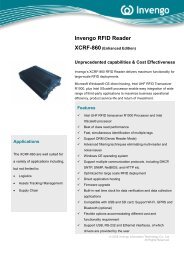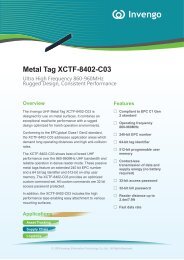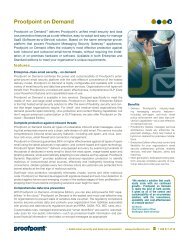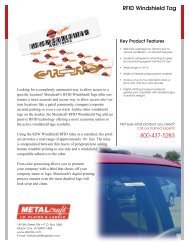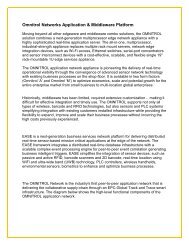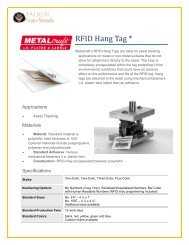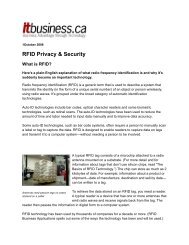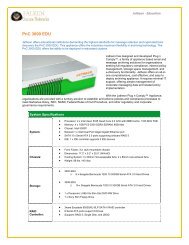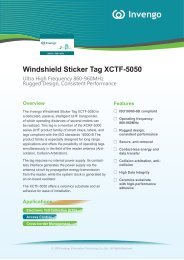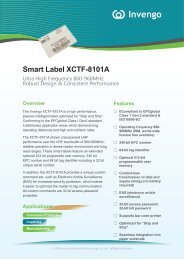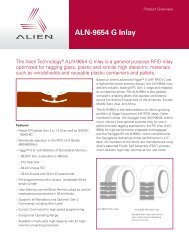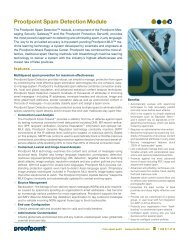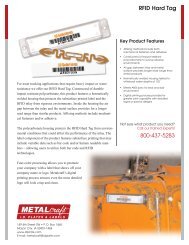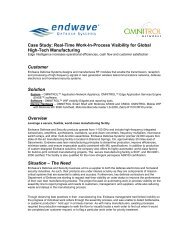The Benefits of RFID for Slab- and Coil-Logistics - Falken Secure ...
The Benefits of RFID for Slab- and Coil-Logistics - Falken Secure ...
The Benefits of RFID for Slab- and Coil-Logistics - Falken Secure ...
Create successful ePaper yourself
Turn your PDF publications into a flip-book with our unique Google optimized e-Paper software.
5.7 S<strong>of</strong>tware plat<strong>for</strong>m<br />
Commonly referred to as <strong>RFID</strong> middleware,<br />
a s<strong>of</strong>tware plat<strong>for</strong>m controls the<br />
<strong>RFID</strong> system, though modern <strong>RFID</strong> solution<br />
packages reach well beyond simple<br />
middleware functionality. In the<br />
simplest terms, the s<strong>of</strong>tware translates<br />
tag reads into business events.<br />
<strong>The</strong> s<strong>of</strong>tware plat<strong>for</strong>m will most likely<br />
be a distributed system. At the very<br />
least, it will run on one or more servers<br />
aggregating data from the transactional<br />
level <strong>and</strong> feeding it into enterprise<br />
resource planning (ERP) <strong>and</strong> warehouse<br />
management systems (WMS).<br />
<strong>The</strong> s<strong>of</strong>tware provides publish <strong>and</strong> subscribe<br />
interfaces to facilitate integration<br />
with other applications. It also provides<br />
abstraction layers <strong>for</strong> connecting various<br />
types <strong>of</strong> readers along with readpoint<br />
monitoring <strong>and</strong> diagnostics.<br />
Almost every <strong>RFID</strong> implementation will<br />
be highly dependent on business rules,<br />
which is why many <strong>of</strong> today’s <strong>RFID</strong><br />
solution packages not only come ready<br />
with basic device control functionality<br />
but also with a business rules engine,<br />
enterprise service bus <strong>and</strong> other components<br />
<strong>of</strong> modern service oriented<br />
architectures (SOA) to facilitate rapid<br />
integration <strong>of</strong> <strong>RFID</strong> into existing business<br />
processes.<br />
<strong>The</strong> cost <strong>for</strong> an <strong>RFID</strong> plat<strong>for</strong>m can vary<br />
enormously depending on the extent<br />
<strong>and</strong> reach <strong>of</strong> the entire system <strong>and</strong> can<br />
be difficult to compare based on different<br />
licensing models. Simple yet usable<br />
products can start from tens <strong>of</strong> thous<strong>and</strong>s<br />
all the way to hundreds <strong>of</strong> thous<strong>and</strong>s<br />
<strong>of</strong> euros <strong>for</strong> large implementations.<br />
5.8 Integration<br />
Integration will be a large factor in <strong>RFID</strong><br />
implementations regardless <strong>of</strong> the s<strong>of</strong>tware<br />
plat<strong>for</strong>m chosen. Depending on<br />
the number <strong>of</strong> legacy systems<br />
involved, costs <strong>for</strong> integration will be<br />
on the order <strong>of</strong> magnitude <strong>of</strong> the cost<br />
<strong>of</strong> readers <strong>and</strong> installation combined.<br />
Some implementations will take a<br />
company well beyond simple integration.<br />
Some systems may need to be<br />
replaced altogether if they are not<br />
capable <strong>of</strong> taking advantage <strong>of</strong> incrementally<br />
large volumes <strong>of</strong> real-time<br />
data provided by <strong>RFID</strong> technology.<br />
5.9 Maintenance<br />
In addition to one-time capital infrastructure<br />
costs, the ongoing maintenance<br />
<strong>and</strong> upkeep <strong>of</strong> <strong>RFID</strong> systems<br />
should be factored into ROI calculations<br />
that are part <strong>of</strong> any business case.<br />
Factors influencing maintenance<br />
include hardware upgrades, failed or<br />
damaged equipment replacement,<br />
ongoing firmware <strong>and</strong> middleware<br />
upgrades <strong>and</strong> any s<strong>of</strong>tware or licensing<br />
fees. Ongoing tag purchases should be<br />
32<br />
factored into operations <strong>and</strong> maintenance<br />
costs. A st<strong>and</strong>ard s<strong>of</strong>tware<br />
license <strong>and</strong> maintenance agreement<br />
usually runs approximately 10 percent<br />
per year. This is a good estimate <strong>for</strong><br />
these systems. Finally, since so much<br />
physical infrastructure is involved,<br />
equipment depreciation must be factored<br />
in as a cost item in a well-built<br />
business case.<br />
5.10 Process<br />
<strong>The</strong> last pieces <strong>of</strong> the <strong>RFID</strong> puzzle are<br />
process <strong>and</strong> human elements. Many<br />
existing processes, especially intercompany<br />
processes, will need to be<br />
redesigned. Current batch or paperbased<br />
processes can be eliminated <strong>and</strong><br />
reinvented entirely through workflow<br />
re-engineering <strong>and</strong> tighter system integration.<br />
Radio-frequency identification technologies<br />
place people in a better position<br />
to act on in<strong>for</strong>mation, because<br />
they can see into the entire supply<br />
chain in real time. This means companies<br />
must increase peoples’ ability to<br />
act on that in<strong>for</strong>mation. Involving personnel<br />
in the design <strong>of</strong> new processes<br />
<strong>and</strong> training them to make the best use<br />
<strong>of</strong> new technology should be added<br />
into overall implementation costs.<br />
Change management is anticipated to<br />
be a necessary discipline <strong>for</strong> fully<br />
addressing <strong>RFID</strong> implementation at<br />
scale.



